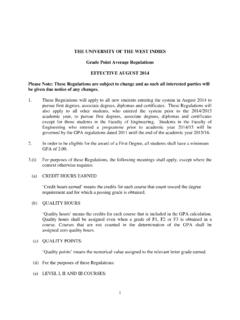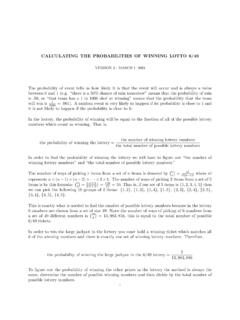Transcription of Value and benefits of the Sports industry
1 1 | P a g e Value and benefits of the Sports industry Introduction Sports is an important sector of economic activity and spans medical treatment and rehabilitation, research and development, Sports tourism, sales and trade of sport products, construction and maintenance of Sports venues, organisation Sports events, and marketing and advertising. It also creates various job and business opportunities ( engineers and developers, coaches and sport doctors, sport journalists and commentators, retailers of Sports goods and equipment, etc.). It is also part of the increasingly important leisure industry and as such, has broader benefits such as boosting productivity, individual and community development as well as reducing the burden of ill health on society. Additionally, it has far reaching implications on the global economy due to its close association with other sectors including education, real estate and tourism. Sports is ranked among the top mainstream activities in the economy.
2 Value of the Sports industry globally Using economic impact methodology, which are largely developed around the estimated number of spectators visiting an event from outside the local region, and the amount those visitors spend on accommodation, food and entertainment etc; the estimated size of the global Sports industry was US$ trillion in 2015 according to Plunkett Research Ltd. A study in 2014 by Kearney, found that the market for Sports events ( revenues for tickets, media rights and sponsorship) is worth close to US$80 billion. Between 2009 and 2013 there was an annual growth of 7 per cent, faster than the GDP of most countries. Moreover, the Sports industry generates as much as US$700 billion annually or a 1 per cent of global GDP when sporting goods, apparel, equipment, and health and fitness spending is included. Table 1 provides a breakdown of global Sports market size by key segments in 2014. Table 1 Breakdown of Global Sports market in 2014 Segment Market Size (Billions US) % Share Sports events 80 Sports apparel, equipment and footwear 310 Sports club (fitness, health and Sports training) 105 Infrastructure construction, food and beverage and betting 200 Total 700 Source Kearney, 2014.
3 Growth is expected to occur across all types of sport. Additionally, revenue of Sports events should continue to grow in the next cycle with projected revenue of $91 billion by 2017, an additional $15 billion Value between 2013 and 2017 ( Kearney,2014). Overall, long-term prospects are strong particularly for the United States, Brazil, the UK, and France. PWC (2014) noted that the North American Sports market was projected to grow across four segments (gate revenues, media rights, sponsorship, and merchandising) from $ billion in 2013 to $ billion in 2018, while Forbes noted the Sports market was worth $ billion in 2014 and is expected to reach $ billion in 2019. Media rights and sponsorships are among the main drivers for revenues with sponsorships and media rights each accounted for 35 per cent of Sports event revenues in 2013, and ticketing accounted for 27 per cent ( Kearney,2014). 2 | P a g e In terms of the composition of the Sports market by region, Europe, the Middle East and Africa (EMEA) has that largest market share of the industry with 48 per cent, larger than North America which accounted for 38 per cent, followed by Asia Pacific with 13 per cent) and Latin America (which likely includes the Caribbean) with 6 per cent in 2013 (see Figure 2).
4 Growth occurred across all types of Sports namely; football, NFL, baseball, Formula 1, NBA, NHL and tennis. Further, key revenues will be mainly generated by a robust growth of football and the fast growing business of rugby or cricket. On a sport by sport basis, football remains the runaway leader with billion followed by American based Sports (American football, baseball, hockey, basketball, stock car racing and college Sports ) with 28 billion (see Figure 3). Spotcal, a Sports market intelligence company located in the United Kingdom, noted that in 2015 there were 83 world championships and multisport games hosted in 119 cities and 38 countries. These events generated over 13 million spectators and generated a potential net impact of $400 million before a single ticket was sold, and an overseas tourism impact worth well in excess of $2 billion. Sports Tourism Analysis by Sportcal shows that an estimated $3 billion of direct economic impact was generated by the 83 world championships and multisport games in 2015 through overseas tourism.
5 These 83 events generated over million bed nights and $437 million of direct economic impact from the event participants and media alone. Using the data gathered on spectator attendance at the 83 events and modelling on the examples available for that period of time, Sportcal estimates that more than 13 million bed nights were created in 2015 by over 2 million overseas visitors, generating a direct economic impact of $ billion for the host economies. Combining these two figures together gives an estimated direct economic impact of over $3 billion (2016, 121). What is the Value of the Sport industry in the Caribbean? There is a paucity of data on the Value of the Sports industry in the Caribbean. For the Latin American region, Sportcal valued the Sports market at $ billion in 2013 or 6 per cent of the global Sports market. The figure for the Caribbean is not known but could be somewhere less than 1 per cent. Caribbean countries have produced world-class sporting talent which far exceeds their small physical and economic sizes.
6 The Caribbean can compete on the world stage in a number of Sports including track and field, cricket, swimming etc. The Chart below show the performance of Caribbean nations in the 2016 Rio Olympics using two Key metrics (1) medals to GDP ratio and (2) medals to population Ratio. EMEA43%North America38%Asia-Pacific13%Latin America6%Figure 2 - Sports event market by region -2013 EMEAN orth AmericaAsia-PacificLatin otherTennisOther(includes Cricket)Formula 1US based sportsFootballFigure 3 - Sports event market by type of sport -2013 (Billions US Dollars)3 | P a g e The Caribbean leads on both counts with Jamaica (medals to GDP ratio and The Bahamas (medals to population ratio). Sport is a multibillion dollar industry , and countries around the world are seeking ways to capitalise on this powerful tool for economic growth and development. For example, the small state of Qatar has identified sport as part of its national strategic plan. Among other upcoming international events, it will play host to the 2022 FIFA World Cup.)
7 Concluding thoughts Sport can be a stimulus for economic growth especially in small, open economies like those in the Caribbean. However, it will require strong institutional support. The University of the West Indies is well positioned to provide strong institutional support to the industry . It already offers sixteen academic sport programmes across the four campuses and routinely produces academic work devoted to Sports development. It also has several sporting facilities on the three residential campuses: The Mona Bowl which is a site of sporting excellence and training for many of Jamaica s top class athletes. The High Performance Centre at the Cave Hill Campus, dedicated to cricket serves the region in providing elite training for regional cricketers the Sport and Physical Education Centre and the Sir Frank Worrell cricket field at St. Augustine has provided a centre for a range of campus, national, regional and international sporting and training activities.
8 4 | P a g e These opportunities for UWI include but are not limited to: Increasing the number of academics Sports programmes on offer. Increasing the use of the Universities athletic facilities to host competitions and invite overseas teams. Development of student athletes into globally respected professional Sports athletes. Establishment of links with Caribbean industries to generate production around sporting equipment. ** References Kearney. Kearney Study: Sports industry Growing Faster Than GDP. November 2014. Kearney. Winning in the Business of Sports . Kearney, 2014. +in+the+Business+of+ BBC Sports . Esports 'set for 1bn revenue and 600 million audiences by 2020'. BBC Sports . 21 March 2017. Plunkett Research Limited. Sports industry Statistic and Market Size Overview, Business and industry Statistics. Statista. Global Sports Market. Statista. revenue-share-by-region/. Sportcal. Global Sports Impact Report 2016.
9 United Kingdom: Spotcal, 2016. University of Florida. The Economy of Youth Sports . University of Florida. March 2015. Telegraph. Discover the potential of sport: a 20 billion industry .

![ABSTRACT arXiv:1803.03635v5 [cs.LG] 4 Mar 2019](/cache/preview/1/d/b/e/e/c/e/5/thumb-1dbeece5f067276ec234853901666198.jpg)


